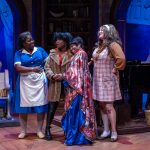4 to Tango

Frank Almond, Stas Venglevski, Nell Buchman (left) and Rosa Borisova, happy after the concert Monday. TCD photo.
Offstage, violinist Frank Almond is one of the funniest people I know. He took it onstage Monday night, at a Frankly Music concert devoted to tango music. The humor had a lot to do with the presence of accordionist Stas Venglevski, who told tall tales and delivered punch lines and straight lines between numbers. In priceless deadpan, Venglevski told of encountering Almond in 1964 in Red Square, where the young violinist was playing for change by Lenin’s Tomb.
“And that’s how we got together,” he said, solemnly, as the audience howled and Almond shook his head.
Almond, baffled by the title of an Astor Piazzolla number, turned to Venglevski: “You’re the Piazzolla expert. Why did he call it Mumuki?”
“He named it after his dog,” Venglevski said.
“Yeah,” Almond replied. “I saw that on Wikipedia, too.”
And on it went, back and forth, more and more fun, Martin and Lewis, through the concert.
The tango, particularly as expressed by Piazzolla, has a dark side, and that was not lost amid all the hilarity. At some point in almost every Piazzolla piece, the harmonies darken, pitch sinks, the rhythm lunges and plunges and everything crashes into a thrilling oblivion. You could feel that gathering weight in their readings of Verano Porteno, Bordel 1900 and even Mumuki. Another Piazzolla signature is long, free, lyrical passages that meander expressively. All the players parsed them beautifully, and that’s not easy. As those passages come to a close, he inevitably sweeps into a new, propulsive mode, usually with a kick-start from a rising chromatic scale very low in the piano. In a concert full of tangos, you come to anticipate that sudden lift, the way you anticipate the gravitational change at the end of an elevator right. Buchman particularly delivered on this suspense.
The bandoneon, a shrill little concertina that seemingly cannot be tuned, and because of that and its timbrel quality can scream like a banshee. Venglevski’s bayan is a far more sophisticated and elegant instrument. He registered to give it a bit of bandonenonic edge, but he let the instrument be itself. The same with the other players; they played with passion, but didn’t go for that certain brutality of real tango bands. That was wise. Better to play the tango your way than to fake Argentine authenticity.
They played some antique (that is, pre-Piazzolla) tangos and some more genteel European tangos (Jealousy) with subtle, campy wit. But even here, the clarity of rhythm and full gestures invited and rewarded attention. The foursome brought electric energy to everything they touched Monday night.
In addition to cracking wise and playing brilliantly, Venglevski arranged all the music. His arrangements were a pleasure to hear and, judging from the nearly constant smiles of his colleagues, a pleasure to play.
This Frankly Music program took place at the Schwan Concert Hall at Wisconsin Lutheran College. Frankly Music will return there on March 21, for an evening of Chopin and Schumann with Almond, pianist Adam Golka and cellist Anthony Ross.

















An evening of tango played straight would have been much less interesting. The three “traditional” tango selections were selected for their familiarity. That was a less appropriate reason. The energy of the evening was in the less familiar blends of classical music and dance.
What we learn from Astor Piazzolla and others is that the rhythms of dance contribute an excitement to contemporary classical music. The best illustration of that was a Bach inspired four part fugue by Piazzolla – Fuga Y Misterio.
Much of Latin American classical music incorporates irregular timing, energized by traditional dance sources. Piazolla’s Verono Porteno introduced ragged strokes, dissonant tones and dramatic development but grounded in dance melodies that kept the work accessible.
Stas’ contribution as arranger was huge. He distributed roles to all four players in ways that echoed a jazz combo. Each instrument was given the opportunity to shine – to take a turn at the melody, to contribute dramatic support often pushing the limits of their instrument, to “drum” the case to support the beat, to introduce dissonant counterpoint, to appear to improvise. (In some cases, Stas was entirely improvising.)
Bordel 1900 was originally written for flute and guitar. I couldn’t tell when violin, cello, piano and bayan were taking the flute or guitar parts. Stas transformed it into a piece designed for this quartet.
MIchael,
Thanks for your comments,and I’ve enjoyed your other writing on this site.
Just to clarify, my understanding is that Stas arranged most of the works we performed, but not all of them. In any case, it was a great pleasure to play this music with such gifted musicians, and hopefully at least some of Piazzolla’s genius came across.
This program was a departure for our series, and a lot of fun as well as an education for me personally.